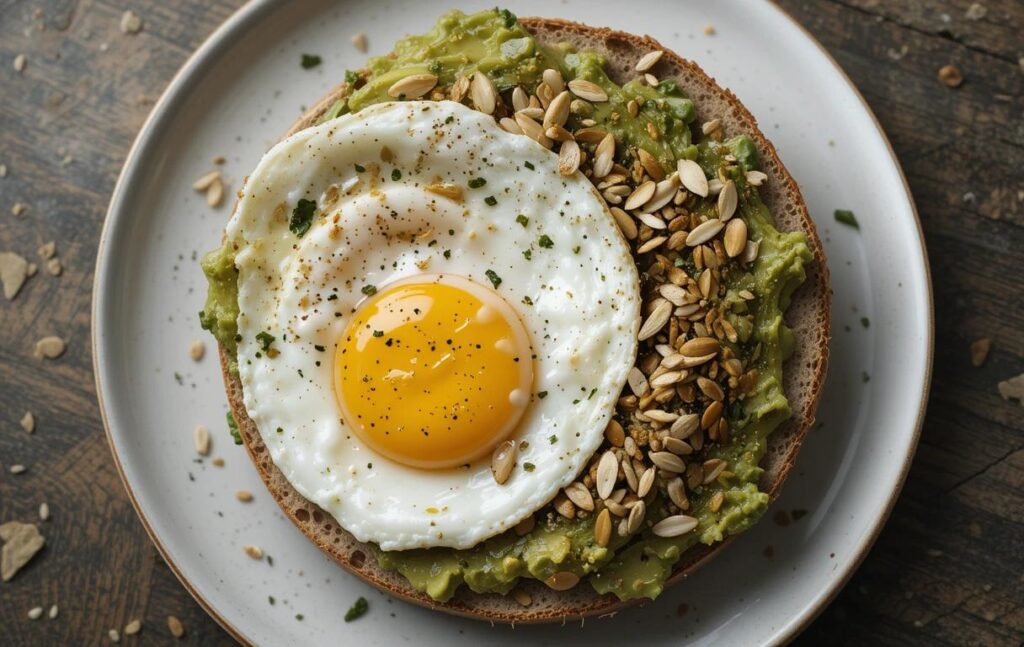Bagels are a beloved breakfast staple worldwide, often enjoyed with cream cheese, lox, or a variety of sweet and savory toppings. But when it comes to choosing between a sourdough bagel and a regular bagel, the differences go beyond flavor alone. While both types share a similar circular shape and chewy texture, the preparation methods, ingredients, and even health benefits set them apart. Understanding these differences will help you make the right choice for your taste buds and dietary preferences.
What’s the difference between a sourdough bagel and a regular bagel?
What Is a Bagel?
A bagel is a round, dense bread with a hole in the middle, often boiled before baking to achieve its characteristic chewy crust and soft interior. Originating in Eastern Europe, bagels have become a popular baked good across the globe, with countless variations in flavors and toppings. Traditional bagels are made from a simple dough of flour, water, yeast, and sometimes sugar or malt syrup to enhance the flavor.
What Sets a Sourdough Bagel Apart?
Unlike regular bagels, sourdough bagels are made using a natural leavening agent called sourdough starter, which consists of fermented flour and water. This gives sourdough bagels a tangy flavor profile and a slightly denser texture. The extended fermentation process also impacts the nutritional composition, often making sourdough bagels easier to digest compared to their traditional counterparts.
Exploring the Unique Characteristics of Sourdough Bagels
The Role of Sourdough Starter
Sourdough starter is the defining ingredient that sets sourdough bagels apart from regular ones. This natural leavening agent is a mixture of flour and water, teeming with wild yeast and beneficial bacteria. The fermentation process not only provides the signature tangy flavor but also creates a unique texture that is slightly denser and more robust compared to the airy fluffiness of regular bagels.
Unlike commercial yeast, sourdough starter requires time and patience to cultivate. Its complex microbial ecosystem works to break down the starches in flour, resulting in a dough that is rich in flavor and easier to digest. This slow fermentation is a hallmark of sourdough baking and makes sourdough bagels stand out in both taste and texture.
Fermentation Process in Sourdough Bagels
The extended fermentation process is another key difference. Sourdough bagels require significantly more time to prepare than regular bagels because the sourdough starter works at a slower pace than commercial yeast. This slower rise allows for a more nuanced flavor profile, with notes of tanginess and umami that develop as the dough ferments.
Moreover, the fermentation process enhances the nutritional benefits of sourdough bagels. The beneficial bacteria in the starter predigest the flour, breaking down gluten and other compounds that can be hard to digest. This makes sourdough bagels a preferred choice for people with mild gluten sensitivities or those seeking a more gut-friendly option.
Characteristics of a Regular Bagel
Regular bagels, on the other hand, are more straightforward in their preparation and ingredients. These bagels are made using commercial yeast, which allows the dough to rise quickly. This fast fermentation process leads to a milder flavor compared to the bold tanginess of sourdough bagels.
Boiling and Baking Method
One aspect that regular and sourdough bagels share is the traditional boiling step before baking. This step is crucial for creating the shiny crust and chewy texture that bagel lovers crave. However, the differences in dough preparation can affect the final texture and appearance. Regular bagels, due to their quicker rise, tend to have a smoother and more uniform crust.
After boiling, the bagels are baked at high temperatures to achieve their golden-brown exterior. Depending on the recipe, some bakers add malt syrup or sugar to the boiling water to enhance the crust’s sweetness and color.
Ingredients in a Regular Bagel
The simplicity of a regular bagel’s ingredient list contributes to its versatile flavor. A standard recipe includes:
- Bread flour for a strong gluten structure
- Water to hydrate the dough
- Commercial yeast to help the dough rise
- Salt for flavor
- Optional sugar or malt syrup for a hint of sweetness
These basic ingredients make regular bagels the ideal blank canvas for a variety of toppings and spreads, from classic cream cheese to more adventurous combinations like peanut butter and bananas.
Texture and Flavor Differences

Tanginess in Sourdough Bagels
One of the most noticeable differences between sourdough and regular bagels is their flavor profile. Sourdough bagels have a distinct tanginess derived from the natural fermentation process. The wild yeast and lactic acid bacteria in the sourdough starter produce complex flavor compounds, resulting in subtle sour notes that pair beautifully with rich or savory toppings.
This tanginess is often described as a more sophisticated taste, appealing to those who enjoy artisanal baked goods. Sourdough bagels also have a slightly nutty undertone, which adds depth to their overall flavor.
Neutral Taste of Regular Bagels
In contrast, regular bagels have a more neutral flavor, making them a versatile choice for a variety of spreads and toppings. The quick-rise commercial yeast used in their preparation creates a mild, slightly sweet dough that complements everything from fruity jams to salty lox.
The neutral taste of regular bagels is one reason they are a staple in American breakfast culture. Their versatility allows bakers to experiment with flavors like blueberry, cinnamon raisin, or everything seasoning without overpowering the base dough.
Textural Contrasts
The texture of sourdough and regular bagels is another point of differentiation.
- Sourdough Bagels: These have a denser and slightly chewier crumb. The natural fermentation process creates irregular air pockets within the dough, resulting in a more rustic texture. The crust is often heartier and less uniform than that of a regular bagel.
- Regular Bagels: With their smoother, more even crumb, regular bagels are fluffier and lighter in comparison. The commercial yeast promotes consistent rising, leading to a softer interior and a crust that is thinner but still chewy.
Why Texture Matters
The difference in texture plays a role in how each type of bagel pairs with toppings. Sourdough bagels, being sturdier, can hold up to heavier toppings like eggs, avocado, or thick spreads. Regular bagels, with their softer crumb, are ideal for lighter, cream-based spreads or sweet combinations.
Flavor Profiles: Which Bagel Wins?
Choosing between the two ultimately comes down to personal preference. If you enjoy bold, tangy flavors and a denser texture, a sourdough bagel may be your go-to. On the other hand, if you prefer a more versatile bagel that can complement both sweet and savory toppings, a regular bagel might suit your taste buds better.
Each type has its unique qualities, making it worthwhile to try both and discover your favorite way to enjoy them.
Nutritional Differences
Calorie and Macronutrient Comparison
When it comes to nutrition, sourdough and regular bagels differ primarily in their ingredient composition and preparation methods. Here’s a breakdown of the key nutritional aspects:
- Sourdough Bagels: Due to their denser texture, sourdough bagels may have slightly fewer calories per gram compared to regular bagels because of their lower hydration level. A typical sourdough bagel (about 100 grams) contains approximately:
- Calories: 250-300
- Protein: 8-10 grams
- Carbohydrates: 50-55 grams
- Fat: 1-2 grams
- Regular Bagels: Regular bagels, especially those made with enriched flour, often have a higher calorie count due to added sugar or malt syrup. A standard regular bagel (100 grams) contains approximately:
- Calories: 270-350
- Protein: 7-9 grams
- Carbohydrates: 55-60 grams
- Fat: 1-2 grams
While both types are carb-heavy, the natural fermentation process in sourdough bagels may alter the way the body processes these carbohydrates, potentially reducing spikes in blood sugar.
Health Benefits of Sourdough Bagels
Sourdough bagels have several health advantages due to the fermentation process.
- Improved Digestibility: The natural fermentation partially breaks down gluten, making it easier for some people with mild sensitivities to digest.
- Lower Glycemic Index: Sourdough’s slower rise may result in a lower glycemic index compared to regular bagels, meaning it has a gentler effect on blood sugar levels.
- Rich in Probiotics: While the baking process kills most of the probiotics in the dough, the prebiotic compounds from the fermentation process support gut health.
- Enhanced Nutrient Absorption: Fermentation improves the bioavailability of minerals like iron and magnesium, allowing your body to absorb these nutrients more efficiently.
Downsides of Regular Bagels
Although delicious, regular bagels are not without their drawbacks:
- Higher Glycemic Index: Regular bagels, especially those made with refined flour, can cause a more significant spike in blood sugar levels.
- Lower Nutrient Content: Without the benefits of fermentation, the minerals in regular bagels may not be as easily absorbed by the body.
- Added Sugars: Many recipes for regular bagels include added sugars, increasing their calorie content without significant nutritional value.
That said, regular bagels remain a convenient and versatile option for those seeking a quick, satisfying meal or snack.
Which Is Healthier?
The choice between sourdough and regular bagels from a nutritional standpoint depends on your dietary needs. If you’re looking for improved digestion and better blood sugar control, sourdough bagels are the healthier choice. However, if you need a quick energy boost or a softer texture, regular bagels may fit the bill.
Best Uses and Pairings

Best Toppings for Sourdough Bagels
Sourdough bagels’ tangy flavor profile pairs beautifully with rich and savory toppings. Here are some delicious combinations:
- Avocado and Poached Egg: The creamy avocado complements the tangy sourdough, while the egg adds protein.
- Smoked Salmon and Dill: The robust flavor of smoked salmon is enhanced by the subtle sour notes of the bagel.
- Hummus and Roasted Vegetables: For a plant-based option, hummus and roasted veggies like red peppers or zucchini are a great match.
- Goat Cheese and Honey: A balance of tangy and sweet, this combination is perfect for brunch.
- Nut Butter and Banana: For a sweet twist, spread almond or peanut butter on a sourdough bagel and top with banana slices.
Classic Pairings for Regular Bagels
Regular bagels are known for their versatility, making them an excellent base for a wide variety of toppings. Popular pairings include:
- Cream Cheese and Lox: A timeless classic, this combination brings together the smooth texture of cream cheese and the salty richness of smoked salmon.
- Egg and Cheese Sandwich: A breakfast staple, this hearty combination pairs perfectly with a softer bagel.
- Peanut Butter and Jelly: A kid-friendly favorite that works well on sweet-flavored bagels like cinnamon raisin.
- Veggie Cream Cheese: Adding chopped vegetables like scallions or carrots to cream cheese makes for a refreshing topping.
- Butter and Jam: Simple yet satisfying, this pairing highlights the mild, slightly sweet taste of regular bagels.
When to Choose Each Type of Bagel
- Sourdough Bagels: Ideal for upscale meals, artisanal spreads, or when you want to enjoy the depth of flavor on its own. They pair best with toppings that enhance their tanginess or rustic nature.
- Regular Bagels: Great for quick, everyday meals or when you want a neutral base to let bold toppings shine. Their softer texture is ideal for sandwiches and sweeter spreads.
Creative Meal Ideas
- Sourdough Bagel Bowl: Hollow out a sourdough bagel and fill it with scrambled eggs, cheese, and sautéed vegetables for a unique breakfast.
- Bagel Pizza: Use a regular bagel as the base, spread marinara sauce, add cheese and toppings, and bake for a quick and easy pizza.
- Mini Bagel Sliders: Slice regular bagels into small rounds, add deli meats, cheese, and greens for an appetizer-friendly snack.
Popularity and Cultural Significance
Bagels have a storied history and a prominent place in global culinary traditions. Originating in Jewish communities in Eastern Europe, bagels became a cultural symbol of community and celebration. They were often served during special occasions and sold by street vendors. Today, bagels are enjoyed worldwide, with sourdough and regular variations reflecting regional preferences and evolving culinary trends.
- Sourdough Bagels: With the rise of artisan baking and a growing interest in natural fermentation, sourdough bagels have become a favorite among health-conscious food enthusiasts and artisan bakers. They are particularly popular in urban areas with vibrant food cultures, where diners seek unique and high-quality baked goods.
- Regular Bagels: As the quintessential breakfast staple, regular bagels are widely consumed across the United States, Canada, and beyond. They are often mass-produced, making them an accessible and affordable choice for families, cafés, and bakeries.
FAQs About Sourdough and Regular Bagels
(What’s the difference between a sourdough bagel and a regular bagel?)
1. Can Regular Bagels Be Made with Sourdough Starter?
Yes, regular bagels can be made using a sourdough starter instead of commercial yeast. This creates a hybrid that retains the shape and texture of a regular bagel but with the tangy flavor of sourdough.
2. Which Bagel Is Healthier: Sourdough or Regular?
Sourdough bagels may have an edge due to their lower glycemic index, improved digestibility, and enhanced nutrient bioavailability. However, regular bagels are a good option for those seeking quick energy or a softer texture.
3. Are Sourdough Bagels Gluten-Free?
No, sourdough bagels are not gluten-free. While fermentation breaks down some gluten, it does not eliminate it. Those with celiac disease or gluten intolerance should avoid sourdough and regular bagels unless made with gluten-free flour.
4. Do Sourdough Bagels Take Longer to Make?
Yes, the sourdough fermentation process takes much longer than using commercial yeast. Sourdough bagels require hours or even days for the starter and dough to ferment, whereas regular bagels can be made in a matter of hours.
5. How Do I Store Sourdough and Regular Bagels?
Both types are best stored in an airtight container at room temperature for 1-2 days or in the freezer for longer preservation. Toasting can help restore freshness for both sourdough and regular bagels.
6. Are Sourdough Bagels Vegan?
Sourdough bagels are often vegan, as their basic recipe includes flour, water, and salt. However, it’s always good to check the recipe for added ingredients like milk, butter, or honey.
Conclusion
Sourdough bagels and regular bagels each bring something unique to the table. Sourdough bagels boast a tangy flavor and potential health benefits, making them ideal for artisanal spreads and sophisticated meals. Regular bagels, on the other hand, are versatile and accessible, serving as a blank canvas for a wide variety of toppings. By understanding their differences in flavor, texture, and nutritional content, you can choose the perfect bagel to suit your taste and occasion.
Whether you’re savoring a sourdough bagel with avocado and eggs or enjoying a classic regular bagel with cream cheese and lox, there’s no wrong way to indulge in this beloved baked good.
Bagel and Cheese Bake
Related Recipes
- “Tuna Tomato Sauce Pasta Recipe“: A tomato-based recipe showcasing another way to use tomatoes.
- “Baked Chicken Fettuccine Alfredo with Broccoli“: Another comforting dish that can be complemented with tomato-based sauces.
Ingredient-Focused Content
- “Lions Mane Mushroom Recipe“: Suggest using a tomato gravy as a flavorful addition for plant-based dishes.
Cooking Techniques and Enhancements
- “Mango Habanero Salsa“: Explore complementary uses of sauces and gravies for flavor diversity.
Storage and Reuse Tips
- “Sous Vide Recipes“: Recommend tomato gravy as a sauce for sous vide-cooked meats or vegetables.
- “Ocean Spray Cranberry Sauce Recipe“: Guide readers on making and storing sauces, including tomato gravy.

